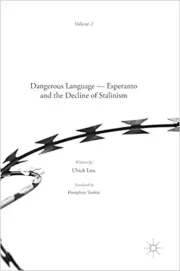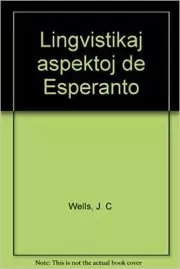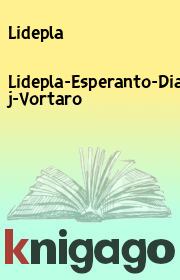Ulrich Lins - Esperanto the Dangerous Language
 | Название: | Esperanto the Dangerous Language |
Автор: | Ulrich Lins | |
Жанр: | Старинная литература | |
Изадано в серии: | неизвестно | |
Издательство: | неизвестно | |
Год издания: | 2017 | |
ISBN: | неизвестно | |
Отзывы: | Комментировать | |
Рейтинг: | ||
Поделись книгой с друзьями! Помощь сайту: донат на оплату сервера | ||
Краткое содержание книги "Esperanto the Dangerous Language"
This work is subject to copyright. All rights are solely and exclusively licensed by the Publisher, whether the whole or part of the material is concerned, specifically the rights of translation, reprinting, reuse of illustrations, recitation, broadcasting, reproduction on microfilms or in any other physical way, and transmission or information storage and retrieval, electronic adaptation, computer software, or by similar or dissimilar methodology now known or hereafter developed.
Читаем онлайн "Esperanto the Dangerous Language". Главная страница.
- 1
- 2
- 3
- . . .
- последняя (95) »
Volume 1
Dangerous Language — Esperanto under Hitler and Stalin
Written by
Ulrich Lins
\ly
-Ur
/y\
Translated by Humphrey Tonkin
Dangerous Language — Esperanto under Hitler and Stalin
"This book gives a carefully supported account of a crucial aspect of the Esperanto movement's history, focusing on political repression by totalitarian regimes, especially those of Hitler and Stalin. It also sheds light on opposition elsewhere and is eye-opening for anyone interested in language policy and global communication."
—Ulrich Ammon, Emeritus Professor of Germanic Linguistics at Duisburg-Essen University, Germany
Ulrich Lins
Dangerous Language — Esperanto under Hitler and Stalin
palgrave
macmillan
Ulrich Lins Bonn, Germany
Translated by Humphrey Tonkin
ISBN 978-1-137-54916-7 ISBN 978-1-137-54917-4 (eBook)
DOI 10.1057/978-1-137-54917-4
Library of Congress Control Number: 2016956885
© The Editor(s) (if applicable) and The Author(s) 2016
The author(s) has/have asserted their right(s) to be identified as the author(s) of this work in accordance with the Copyright, Designs and Patents Act 1988.
This work is subject to copyright. All rights are solely and exclusively licensed by the Publisher, whether the whole or part of the material is concerned, specifically the rights of translation, reprinting, reuse of illustrations, recitation, broadcasting, reproduction on microfilms or in any other physical way, and transmission or information storage and retrieval, electronic adaptation, computer software, or by similar or dissimilar methodology now known or hereafter developed.
The use of general descriptive names, registered names, trademarks, service marks, etc. in this publication does not imply, even in the absence of a specific statement, that such names are exempt from the relevant protective laws and regulations and therefore free for general use.
The publisher, the authors and the editors are safe to assume that the advice and information in this book are believed to be true and accurate at the date of publication. Neither the publisher nor the authors or the editors give a warranty, express or implied, with respect to the material contained herein or for any errors or omissions that may have been made.
Cover image © Desintegrator / Alamy Stock Photo Cover design by Samantha Johnson
Printed on acid-free paper
This Palgrave Macmillan imprint is published by Springer Nature The registered company is Macmillan Publishers Ltd.
The registered company address is: The Campus, 4 Crinan Street, London, N1 9XW, United Kingdom
Editorial Note
Transliteration from Russian and Ukrainian is based on the Library of Congress system. To make it easier on the reader, in Russian family names the ending 'ii' has been changed to 'y', and soft signs and diacritics have been omitted. In the footnotes and bibliography, however, I have followed standard Library of Congress transliteration. In references, in general, a translation is added only if the original is not in Roman script; names appear in the form used in the publication in question.
For individuals from East Asian countries the family name appears first, and the given name follows.
In the notes the full title of a book is indicated only in the first refer- ence in the chapter in question; in subsequent notes it appears in abbrevi- ated form. For frequently cited works (among them EdE, EeP, PVZ), see the list of abbreviations and, of course, the bibliography. Only in excep- tional cases are electronic sources indicated (links were last checked on 28 September 2016) In the case of journal articles, the title of the periodi- cal is normally followed by the volume number and year of publication. Where pagination extends over the entire volume, I have not indicated the specific issue in which the article appears.
U.L.
Preface
Every book has its history, this one included. Its earliest draft was published in 1973 by the publisher l'omnibuso in Kyoto, Japan. This version, little more than a pamphlet, had a tiny print run, but a year later its contents were printed as a section in the volume Esperanto en perspektivo. In 1975 an expanded version of the first edition appeared in Japanese translation, the work of Kurisu Kei. It was published in Tokyo by Iwanami.
In 1988 a new, completely rewritten text was published—the result of several years of research in a vast array of source material.[1] It was my desire to make an original contribution to research on the 100-year his- tory of Esperanto, devoting particular attention to a specific aspect of that history—an aspect long neglected, indeed regarded as something of a taboo, even among Esperantists. The topic was the opposition and persecution that Esperanto encountered for political and ideological rea- sons. I wanted to describe the fate of the adepts of a language that, over the decades, police, censors, nationalist ideologues and assorted dictators had denounced as 'dangerous'.
So I did not deal with the 'internal' history of the Esperanto movement so much as with the hostile reactions that Esperanto and its speakers had endured from political regimes and ideologies, particularly Nazism and Stalinism. Likewise, it was not enough simply to limit the story to a description of the ways in which Esperanto had been attacked: it was important to present the arguments of its opponents and analyze the motives that prompted political regimes of very different character to harass the movement for Esperanto. Such motives could derive from fundamental ideological positions or from concrete political interests. In this same connection, I also tried to shed light on the attitudes of the movement itself, and of individual Esperantists: without an aware- ness of the origins of the language, the motives of Zamenhof, the modes of recruitment and the theory and structure of the movement, we can hardly hope to achieve an understanding of why Esperanto became such an object of persecution.
New information, particularly archival material, has come to light since the 1988 edition and the fall of the Berlin Wall in the follow- ing year. So the present version of the study is different again. For the English-language version, I have expanded the story into two volumes, the first dealing with the persecution of Esperanto speakers and the sup- pression of the language in Hitler's Germany and Stalins Russia, and the second describing the underlying causes of the demise of the language in the Soviet Union and its revival, first in Eastern Europe and then in Russia itself, after the death of Stalin and the gradual decline of the ideas we associate with
--">- 1
- 2
- 3
- . . .
- последняя (95) »
Книги схожие с «Esperanto the Dangerous Language» по жанру, серии, автору или названию:
 |
| Fians, Guilherme - Esperanto Revolutionaries and Geeks: Language Politics, Digital Media and the Making of an... Жанр: Старинная литература Год издания: 2021 |
 |
| J. C. Wells - Lingvistikaj aspektoj de Esperanto Жанр: Старинная литература Год издания: 1989 |
 |
| Ulrich Lins - La Danĝera lingvo Жанр: Старинная литература Год издания: 1988 |



